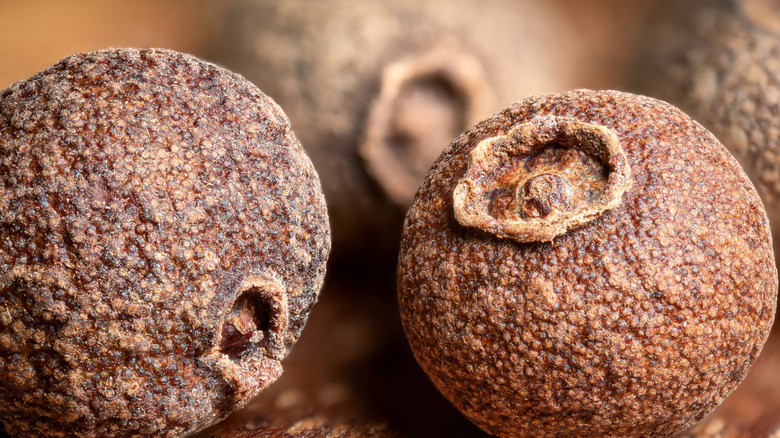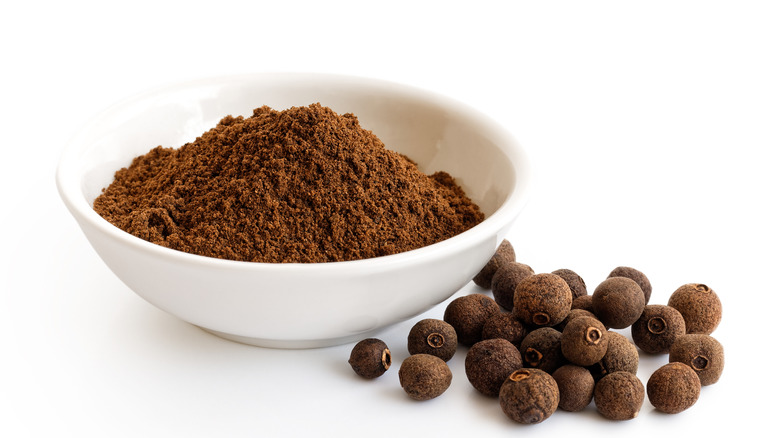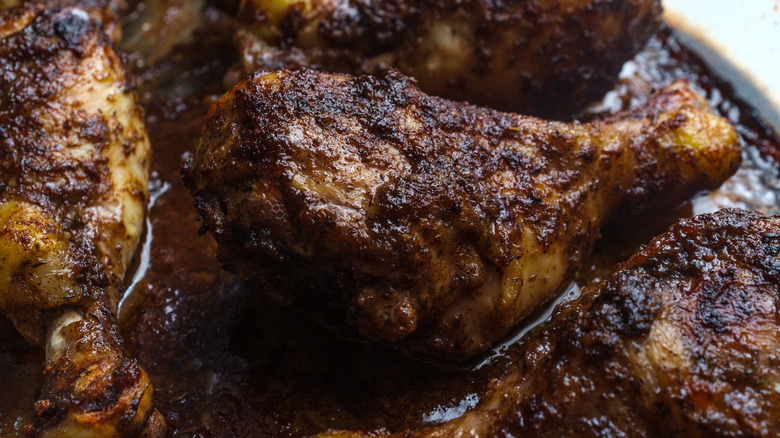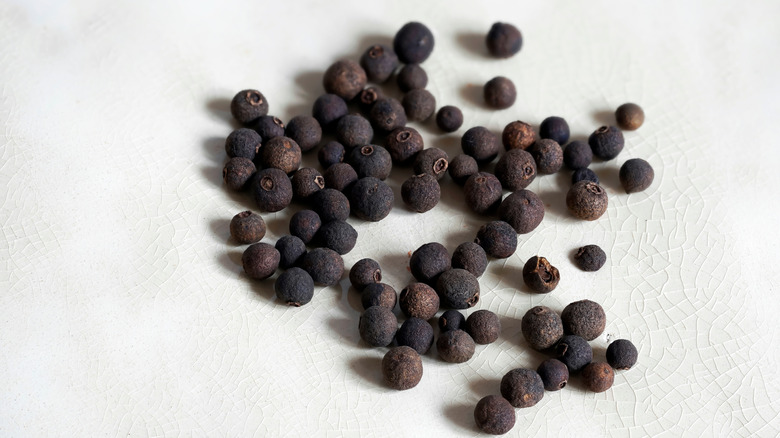What Is Allspice And How Do You Use It?
Often conflated with other spices that have a similar warming quality and slightly spiced fragrance and flavor, allspice can slip under the radar. Many people aren't clear at all about what exactly allspice is: it is a blend like five-spice powder? What does it taste like on its own? How is it used? If you've pondered these questions, you've come to the right place.
While the somewhat confusing name might suggest that the spice is a blend or mix, it is not! According to The Spruce Eats, Allspice comes from one particular plant, the pimenta diocia. Allspice is derived from the dried berries of the evergreen tree, which can be used either whole or ground. The Spruce Eats also notes that the leaves of the allspice tree can be used like bay leaves — placed whole into a dish whole to impart flavor — and the allspice wood is even used for smoking meats.
What is the history of allspice?
Historically found and used through parts of the Caribbean and Central and South America, allspice was introduced to Europeans by Christopher Columbus (via Spice Advice). He'd been hoping to find pepper — a precious commodity at the time — and the allspice's berry's resemblance to the peppercorn initially caused some disappointment for the traders hoping to find a lucrative new pepper source (via MySpicer). Taste notes that a member of Columbus's crew called the spice "pimenta" after the Spanish word for pepper (it's also called pimento in the West Indies). Only later did Europeans begin calling it allspice, after noting that the ground dried berries taste similar to a mix of other spices like cinnamon, clove, black pepper, and nutmeg (via Saveur).
The Arawak peoples of South America and the Caribbean are said to have originated the use of crushed allspice, primarily to season meats, according to Saveur. Seedlip notes that the Mayans actually used allspice as an embalming agent, and also in the production of chocolate, often deepening the rich flavor. The Epicentre states that allspice is the only spice grown exclusively in the Western hemisphere because its evergreen trees are indigenous to South and Central America. While it is grown throughout Guatemala, Honduras, and other South and Central American countries, the finest allspice is said to come from Jamaica, due to climate and soil specifications. It is even still called Jamaican pepper in some areas. Seedlip also notes that allspice is also sometimes called "bayberry."
How do you cook with allspice?
Allspice has a similar flavor profile to spices like cinnamon, cloves, and nutmeg: warming and full, with a touch of spice or bite (via The Spruce Eats). It is used in both savory and sweet dishes, and is often found in Caribbean, Middle Eastern, and Latin American cuisines. Many baked goods call for ground allspice, while some savory dishes might use the entire clove/berry — such as in a pickling recipe. It is famously one of the primary ingredients to season Jamaican jerk chicken, and is also used to flavor foods such as beef patties, Swedish meatballs, and holiday desserts such as spice cakes or gingerbread. It is superb with roasted vegetables and is often used in many Middle Eastern and Greek dishes. It's popular in mincemeat pie, desserts redolent with pumpkin spice, ketchups, gravies, in warmed apple ciders and jammy fruit pies, according to Masterclass. It is great in stews and braises, with sauerkraut or cabbage, or used in Cincinnati-style beef chili (via The Spruce Eats). Seattle Times notes that many people in Jamaica also soak the berries in rum to create a special, slightly bitter, allspice-infused liquor. Allspice is also used to make Benedictine and Chartreuse liqueurs.
Is allspice good for you?
From a nutritional standpoint, the amount of allspice in standard recipes is generally so small that it doesn't have much of an effect (via Masterclass). However, its oil has microbial, anti-inflammatory compounds that can help to soothe an upset stomach or cramps. Its oil also has powerful restorative and healing properties, similar to clove oil, and can be used topically to increase blood flow to the skin and warm the area (via The Epicentre). Due to this, allspice oil can be helpful to treat arthritis, aches, or sore muscles.
HuffPost notes that it takes about 5,700 berries to make a pound of ground allspice — wow! Clearly, there is a ton of labor needed to produce even just a pound of allspice, so don't take it for granted the next time you sprinkle a dash into a cake batter. As the Arawak discovered hundreds and hundreds of years ago, allspice is an all-purpose ingredient and curative spice that is wildly versatile – and not to mention, absolutely delicious.



